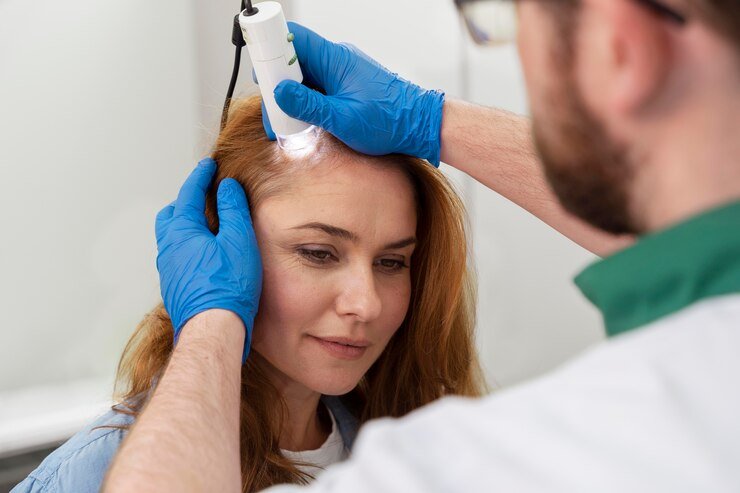Hair loss is a widespread concern that affects millions of individuals worldwide. Whether caused by genetics, aging, hormonal imbalances, or other factors, losing hair can significantly impact self-esteem and confidence. While there are numerous treatments available, Platelet-Rich Plasma (PRP) therapy has emerged as a cutting-edge, non-surgical option for promoting hair growth and restoring thicker, healthier hair. In this article, we’ll explore the concept of Hair PRP treatment, how it works, its benefits, and what to expect from the procedure.
Understanding Hair PRP Treatment
PRP therapy is a medical treatment that utilizes the body’s own blood components to stimulate tissue regeneration and healing. In the context of hair restoration, PRP involves using the platelets, which are rich in growth factors, to rejuvenate and revitalize hair follicles. The procedure begins with a small amount of blood being drawn from the patient, typically from the arm. This blood is then processed in a centrifuge to separate the plasma from other components like red blood cells and white blood cells. The resulting PRP, which contains a high concentration of platelets, is then injected into the scalp in areas experiencing hair thinning or hair loss.
How PRP Works for Hair Restoration
The key to PRP’s effectiveness lies in its ability to promote healing and regeneration by harnessing the body’s natural healing properties. Platelets contain growth factors that are essential for tissue repair and regeneration, which includes stimulating dormant hair follicles to re-enter the growth phase (anagen phase) of the hair cycle. By introducing a concentrated dose of platelets directly into the scalp, PRP therapy enhances the blood supply to the hair follicles, which improves the overall health of the scalp and stimulates the production of new hair.
When administered properly, PRP has been shown to improve hair density, thickness, and the overall health of existing hair. It can also prevent further hair loss and slow down the progression of thinning. The treatment is especially effective for individuals with androgenetic alopecia (male or female pattern baldness), though it may also benefit those with other forms of hair loss, including traction alopecia or hair thinning caused by stress, poor nutrition, or medical conditions.
Benefits of Hair PRP Treatment
- Non-Surgical and Minimally Invasive: One of the major advantages of PRP therapy is that it is a non-surgical procedure, meaning no incisions, stitches, or recovery time is required. The procedure is relatively quick, typically lasting 30 to 45 minutes, and can be done on an outpatient basis.
- Natural Treatment: Since PRP uses the patient’s own blood, there is a reduced risk of allergic reactions or complications that can arise with synthetic treatments or foreign substances. The body readily accepts PRP, making it a natural, safe treatment option.
- Stimulates Hair Regrowth: By stimulating the hair follicles and improving the blood flow to the scalp, PRP promotes hair regrowth in thinning or balding areas. Over time, patients may notice thicker, healthier hair as a result of this treatment.
- Little Downtime: Unlike traditional hair restoration surgeries, PRP therapy involves minimal downtime. Patients can resume normal activities shortly after the treatment. However, some individuals may experience mild redness or swelling at the injection sites, which typically resolves within a day or two.
- Safe and Effective: PRP therapy has been used in a variety of medical fields for years, including orthopedics and dermatology, for its ability to enhance tissue healing. Its success in promoting hair regrowth has been supported by numerous clinical studies, showing that PRP can significantly improve hair density and reduce hair shedding.
- Long-Lasting Results: While results from PRP therapy are not immediate, patients typically begin to notice improvements in hair thickness and regrowth after a few months. With consistent treatments, the results can be long-lasting. Maintenance sessions are usually recommended every 4 to 6 months to sustain the effects.
What to Expect During the Procedure
Before undergoing a PRP hair treatment, patients will undergo a consultation with a qualified healthcare provider to determine if they are a suitable candidate. During this consultation, the doctor will assess the patient’s hair loss pattern, medical history, and overall health to ensure the best possible outcome.
The procedure itself is relatively straightforward. After blood is drawn and processed to isolate the PRP, the patient’s scalp will be numbed with a local anesthetic to minimize discomfort during the injections. The PRP is then injected into targeted areas of the scalp, focusing on areas where hair loss is most noticeable. Depending on the extent of hair loss, multiple injections may be necessary.
Post-Treatment Care and Considerations
Following the PRP treatment, patients are generally advised to avoid strenuous physical activities for a few days to minimize swelling or irritation. Additionally, patients should refrain from washing their hair for at least 24 hours to allow the PRP to fully absorb into the scalp.
While PRP therapy is generally safe, there are a few considerations to keep in mind. Some individuals may experience mild tenderness, redness, or swelling at the injection sites, but these side effects are temporary. In rare cases, individuals with blood disorders or certain medical conditions may not be suitable candidates for PRP treatment.
Conclusion
Hair PRP treatment offers a promising, minimally invasive solution for individuals struggling with hair thinning or loss. By utilizing the body’s natural healing processes, this therapy stimulates hair growth and improves scalp health, providing a safe and effective option for many patients. Although results vary depending on the individual, PRP therapy has gained significant popularity in recent years as a reliable, non-surgical approach to hair restoration.
For those seeking to combat hair loss without the need for invasive surgery, Hair PRP treatment presents an exciting opportunity. As with any medical procedure, it is essential to consult with a qualified and experienced practitioner to determine if this treatment is right for you. With the right care and consistent follow-up, PRP therapy can be a transformative treatment for regrowing and revitalizing hair.










































